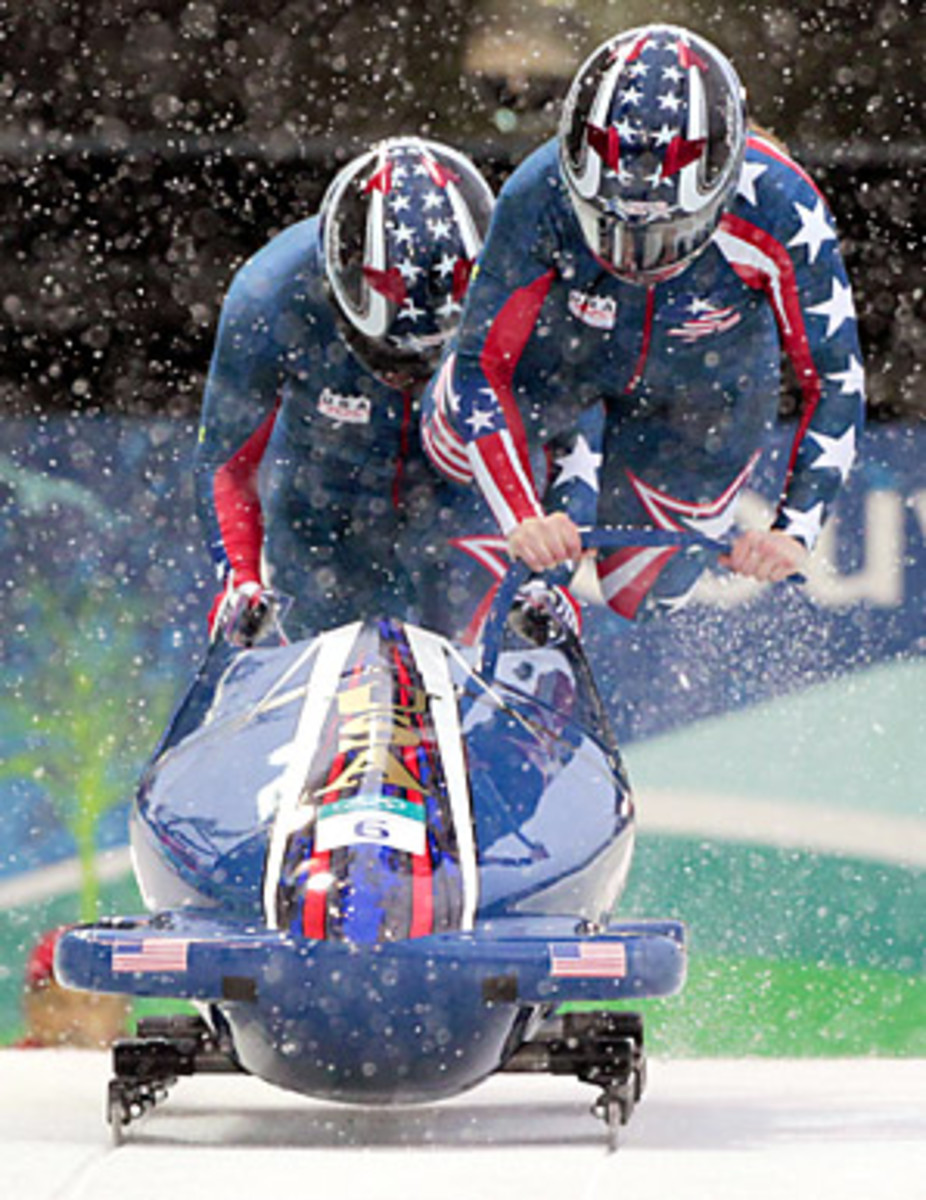
U.S. in bobsled medal hunt with help from 'savior' Bodine
A U.S. two-woman bobsled sits in second place heading into Wednesday's final two runs, but it isn't the American sled everyone predicted. Everyone except perhaps driver Erin Pac and her brakewoman Elana Meyers, that is.
Pac and Meyers make up the "USA 2" sled, so named because it is supposed to be the second best of the three US bobsled teams in Whistler, behind USA 1, which is piloted by Shauna Rohbock, the silver medalist from the 2006 Games in Turin.
But when the sleds got going Tuesday night under the lights and a serene snowfall, it was Rohbock who had trouble staying off the walls on curves four and five, while Pac sped to second place just 0.13 seconds behind Canada 1, driven by Kaillie Humphries. On her first run, Pac appeared to be a bit out of control as her sled swung high up on several curves, but she was able to make corrections each time without pinballing off the walls. "I've done so many mental runs on this track and I've watched so much video," said the 29-year-old Pac, "it happened just like second nature."
Pac admitted that curve 13 -- the so-called 50-50 curve because sliders joke that's the chance they have of making it through without crashing -- "scares me so much" she said, "but I like the thrill." And the fear didn't hurt her performance. Nor did it hurt the performance of USA 3 driver Bree Schaaf, who sits tied for sixth place with Rohbock. "You're standing at the top and thinking you're ready to vomit," said of the difficulty and speed of the course, which topped 90 mph at times Tuesday.
One spectator at the Whistler Sliding Centre was particularly proud to see bobsleds bearing "USA" decals whizzing past into three of the top seven spots, and that's because he helped buy and build the sleds.
NASCAR legend Geoff Bodine first got the idea to invest in American-made bobsleds for American athletes when he was watching the 1992 Winter Olympics, held in Albertville, France. Bodine, now 50, was drawn to the sport "because it was a racing-type event in a vehicle," like NASCAR, he says. But he was not impressed with the highest American finishes, seventh in the two-man and ninth in the four-man. (Women's bobsled was added to the Olympics in 2002).
After watching the '92 Games, Bodine flew with a friend from his North Carolina home to visit the bobsled track in Lake Placid. There bobsledder Bruce Rosselli gave Bodine a ride and even let him drive the sled a little. He also informed Bodine that bobsledder's had to raise their own money in order to buy used sleds that the juggernaut Germans had discarded. "When I saw what he had to ride," says Bodine, "I said, 'I could build a better one than this.'" And so he did.
Bodine's bobsled trip made the news, and by the time he called his friend and racecar chassis builder Bob Cuneo, Bodine didn't even have to ask. "You want me to build a bobsled," Bodine recalls Cuneo saying when he picked up the phone. The two agreed that Americans should be riding in American-made sleds with proprietary American technology, and so began the Bo-Dyn Bobsled Project -- "Bo" for Bodine and "Dyn" for Cuneo's Chassis Dynamics.
Bodine invested about a half-million of his own dollars to get the first Bo-Dyn sled on the track for the '94 games in Lillehammer, Norway, and the project has raised and spent a little over $2 million since it began. The U.S. bobsled team now has a garage by the Lake Placid track filled with over a dozen Bo-Dyn sleds -- which only Bo-Dyn mechanics are allowed to tinker with. Brian Shimer, coach of the U.S. men's bobsled team, and the driver of that seventh place two-man sled that Bodine saw in '92, says that the Bo-Dyn Bobsled Project "has been the savior of our sport in this country." Shimer went on to take bronze in the four-man at the 2002 Olympics in Salt Lake City, while American driver Todd Hays took silver. Bodine takes pride in achievements like Rohbock's silver in '06 and the world championship title that the US four-man "Night Train" team won last year, but he says that the main goal was to get American athletes American sleds "where they didn't have to worry about raising funds to buy them," Bodine says. "The rest is a bonus."
Bodine's generosity has conferred some more tangible bonuses as well. Bodine has had the chance to drive more sleds and annually brings NASCAR drivers to Lake Placid for the Bodine Challenge, where they try their hands at driving bobsleds -- though not from the start at the top of the track that bobsled pros use.
"People think that for drivers who go 200 mph in a car, going 55 mph in a sled has got to be boring," Bodine says. "But in car racing, we have control of speed. We have a steering wheel, and brakes, and gas. We can turn it off. In bobsled, once you start, Mother Nature is the engine. That out of control feeling is an adrenaline boost for a race driver. When they get out of the sleds at the finish, their eyes are as big as race tires, and they're out of breath."





